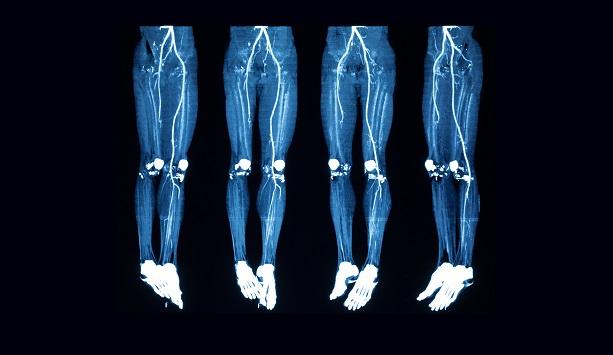PVI in Symptomatic Lower-Extremity PAD Offers Multiple Benefits, Even 2.5 Years Later
Observational data from LIBERTY 360 show high freedom from amputation and improved quality of life across Rutherford classes.

HOLLYWOOD, FL—Patients who undergo peripheral vascular intervention (PVI) for symptomatic lower-extremity PAD derive long-term benefits, according to 2.5-year data from the LIBERTY 360 trial presented last week.
The study is unique in that it allowed the use of any US Food and Drug Administration-approved technology to treat claudication and critical limb ischemia (CLI) and the patient population was “almost all-comers,” Jihad A. Mustapha, MD (Michigan State University, East Lansing), told attendees at the International Symposium on Endovascular Therapy (ISET).
Intermittent claudication “is really nothing that we can take lightly,” Mustapha emphasized at the outset of his presentation. Citing data from a 2018 paper on PAD epidemiology, he pointed out that over a 5-year time span, up to 20% of patients with intermittent claudication will significantly deteriorate, of whom two-thirds will have worsening claudication and one-third will develop CLI (Rutherford class 4-6). For those with CLI, 30% will undergo amputation within a year of diagnosis and 20% will die, leaving only 45% alive with both legs intact.
W. Schuyler Jones, MD (Duke University Medical Center, Durham, NC), who served as a LIBERTY 360 site investigator at his center, told TCTMD that he’s continuing to sift through the data set to better understand how patient characteristics might affect treatment decisions and outcomes.
LIBERTY 360 provides a contemporary look, starting in May 2013, at “how patients get treated in cath labs and angio suites around the country,” he explained, noting that sites ranged from large academic medical centers to small practices.
“My interest in this is just to make observations on what occurs,” which is of interest given the overall lack of evidence on the treatment and trajectory of patients with severe PAD, Jones said. “When you look at the anatomic data that’s there, it’s pretty rich data, so it will tell us a lot about limb events and limb symptoms over time.”
What LIBERTY 360 won’t reveal is whether “a device or a treatment pathway is better, because the patients all got endovascular intervention and the device choice was up to the operator at the time,” he explained.
LIBERTY 360 at 2.5 Years
With a planned follow-up of 5 years and core-lab adjudication, the 51-center LIBERTY 360 trial is tracking outcomes of 1,204 patients who started out in Rutherford class 2 to 6. Most were treated with balloon angioplasty and/or atherectomy. A minority underwent stenting.
Around 75% of patients in the original cohort completed 6-month follow-up, and 57% had 2-year follow-up. Between baseline and 2 years, patients experienced significant improvement in Rutherford class no matter which class they started out in prior to the study. “No one expected Rutherford 6 patients to do as well as they did,” Mustapha said.
Another promising finding, he added, is that pain levels on the Vascular Quality of Life Questionnaire (VascuQol) decreased for all Rutherford categories, and eventually converged such that patients in class 6 had no more pain than those in 2-3 or 4-5. VascuQol scores also improved with regard to symptoms, physical activity, emotions, and social functioning.
Across Rutherford groups, results showed that “therapy at any level will lead to wound healing and wound salvage,” Mustapha said.
Even though patients in this “real-world” study represented a challenging population in terms of previous lower-extremity interventions, history of MI, long lesions, and chronic total occlusion, freedom from major amputation at 2.5 years was high no matter whether patients were in class 2-3 (98.8%), 4-5 (94.6%), or 6 (79.9%), he pointed out. Rates of freedom from 2.5-year TVR/TLR were similar in Rutherford classes 4-5 (64.7%) and 6 (65.7%).
We still need more data. W. Schuyler Jones
Orbital atherectomy appears to provide particularly good outcomes, according to the results presented at ISET, but Jones urged caution in interpreting this, since all the operators participating in that subanalysis were highly experienced.
For Jones, the 2.5-year follow-up from LIBERTY 360 is best described as “hypothesis-generating. It helps with the overall message of PAD care, especially with Rutherford 4, 5, and 6, but my conclusion would be: we still need more data.”
Caitlin E. Cox is News Editor of TCTMD and Associate Director, Editorial Content at the Cardiovascular Research Foundation. She produces the…
Read Full BioSources
Mustapha JA. LIBERTY 360: 2.5-year data. Presented at: ISET 2019. January 29, 2019. Hollywood, FL.
Disclosures
- LIBERTY 360 is sponsored by Cardiovascular Systems Inc.
- Mustapha reports having various connections to BD Bard, Boston Scientific, Biothelium, Cagent Vascular, Cardio Flow, Cardiovascular Systems Inc, Medtronic, Micromedical Systems, Philips, PQ Bypass, Reflow Medical, and Terumo Medical.


Comments